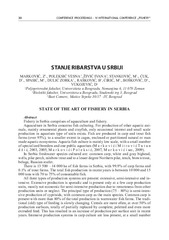Приказ основних података о документу
State of the Art of Fishery in Serbia
Stanje ribarstva u Srbiji
| dc.creator | Živić, Ivana | |
| dc.creator | Stanković, Marko | |
| dc.creator | Cuk, D | |
| dc.creator | Spasić, M | |
| dc.creator | Dulić, Zorka | |
| dc.creator | Rašković, Božidar | |
| dc.creator | Ćirić, M | |
| dc.creator | Bošković, D | |
| dc.creator | Vukojević, D | |
| dc.creator | Marković, Zoran | |
| dc.creator | Poleksić, Vesna | |
| dc.date.accessioned | 2020-12-17T23:07:20Z | |
| dc.date.available | 2020-12-17T23:07:20Z | |
| dc.date.issued | 2009 | |
| dc.identifier.uri | http://aspace.agrif.bg.ac.rs/handle/123456789/5498 | |
| dc.description.abstract | Fishery in Serbia comprises of aquaculture and fishery. Aquaculture in Serbia concerns fish culturing. For production of other aquatic animals, mainly ornamental plants and crayfish, only occasional interest and small scale production in aquarium type of units exists. Fish are produced in carp and trout fish farms (over 95%), to a smaller extent in cages, enclosed or partitioned natural or man made aquatic ecosystems. Aquaria fish culture is mainly low scale, with a small number of specialized breeders and one public aquarium (M a r k o v i ć i M i t r o v i ć T u t u n d ž i ć, 2003, 2005; M a r k o v i ć i P o l e k s i ć, 2007, M a r k o v i ć i sar., 2009). In Serbia freshwater species cultured are: common carp, white and gray bighead, wells, pike perch, rainbow trout and to a lesser degree Northern pike, tench, brown trout, beluga, Russian starlet. There is 13 500 – 14 000 ha of fish farms in Serbia, with 99.9% of carp farms and 0.1% of trout farms. The total fish production in recent years is between 10 000 and 15 000 tons with 70 to 75% of consumable fish. All three types of production systems are present: extensive, semi-intensive and intensive. Extensive production is sporadic and is present only at a few carp production units, mostly not economic for semi-intensive production due to remoteness from other production units or neglect. The principal type of production (75 – 80%) is semi-intensive production of cyprinids, with common carp as the main species. Common carp is present with more than 80% of the total production in warmwater fish farms. The traditional (old) type of feeding is slowly changing. Cereals are more often, at over 50% of production surfaces, totally of partially replaced by complete, peletted and even more extruded feed. This has resulted in an increase of production per surface unit in recent years. Intensive production systems in carp culture are less present, at a small number of earthen ponds with aeration systems, mainly for fish fry production, and in cages. However, rainbow trout, the only salmonid species cultured for consummation, is exclusively produced in intensive systems at trout farms in Serbia. The number of people involved full-time in fish production in Serbia is about 1100 and approximately 400 seasonal workers that are hired mainly prior to harvest. With the rising of standard and returning to traditional habits during religious fasting, as well as with a slow increase of “healthy food” supporters, fish consumption has a growing trend. However, although fish production is increasing in recent years, the country’s production and open-water capture fishery barely represent a quarter of the total needs of inhabitants. This results in increase of import, mainly marine and frizzed fish, but also freshwater fish. Open-water capture fishery is performed in Serbia’s fishing waters. They are represented by 66 000 km of water currents (rivers and streams), flood plains, backwaters, 50 lakes, 150 reservoir lakes and around 30 000 km of canal systems, hydromeliorative systems, as well as all other waters with fish. All fishing waters are divided into 6 fishing regions (Serbia – Vojvodina, Serbia – West, Serbia – South West, Srbia - South, Serbia – East, Serbia – Center) since year 2007. Sports fishing is obtainable at all regions but commercial fishery is aloud only at two regions (Serbia – Vojvodina, Serbia – west), and in rivers Tisa, Sava and Danube. Number of fisherman with purchased license in the last couple of years is between 50 000 and 100 000. Number of commercial fishermen is between 500 and 2000 in the last ten years. The amount of captured fish is between 2000 and 3000 tons in the few past years. | en |
| dc.relation | info:eu-repo/grantAgreement/EC/FP7/205135/EU// | |
| dc.relation | info:eu-repo/grantAgreement/MESTD/MPN2006-2010/20047/RS// | |
| dc.rights | openAccess | |
| dc.source | 4. International Conference “Fishery” Faculty of Agriculture, Belgrade-Zemun, Serbia, May, 27 - 29. | |
| dc.subject | fishery | en |
| dc.subject | state of Art | en |
| dc.subject | perspectives | en |
| dc.subject | Serbia | sr |
| dc.title | State of the Art of Fishery in Serbia | en |
| dc.title | Stanje ribarstva u Srbiji | sr |
| dc.type | conferenceObject | |
| dc.rights.license | ARR | |
| dc.identifier.fulltext | http://aspace.agrif.bg.ac.rs/bitstream/id/3992/5495.pdf | |
| dc.identifier.rcub | https://hdl.handle.net/21.15107/rcub_agrospace_5498 | |
| dc.type.version | publishedVersion |


